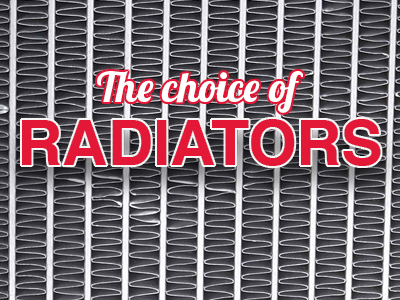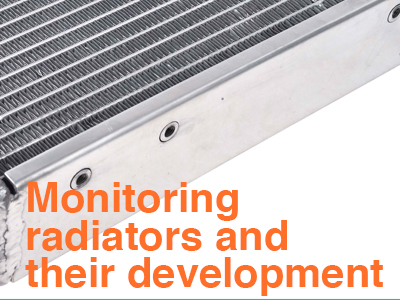C-ARA4442, C-ARA4443, C-ARA44443 HI PERFORMANCE RADIATORS
These radiators were developed to provide superior cooling capability over the standard equipment where non standard engines are being used.
Choice of radiators

Choice of radiators
Radiators Read about heat conductivity, core, fin design, tube sizes and design changes
Monitoring Radiators development since 1960.

Monitoring Radiators development since 1960.
I have been monitoring radiators and their development since the late 1960’s because they were and still can be a problem when tuning cars.
I have seen,
tried and tested everything made available or offered to Mini Spares
Historical Article-August 1994-The truth, the whole truth and nothing but the tr...
THE TRUTH, THE WHOLE TRUTH AND NOTHING BUT THE TRUTH!
When we started on the electronic management system for our 8-Port, it was also our idea to make a system for the latest fuel injection Minis.At the same time,Glyn Swift (Swiftune) had started work on a unit with M.B.E.Electronics,but even at a fairly advanced stage, it was still having reliability problems,so it was withdrawn from the market. Swiftune,as you will know from previous articles....
Primary Gear - Bush Replacement
With the cost of new primary gears spiralling ever upwards, and the availability of good, serviceable used ones, fitting new bushes to existing gears is becoming a more common solution. For some reasons for bush failures and rectification to stop it re-occurring, see article Primary gear - Bush problems. Since there is no useful information given in any of the workshop or DIY manuals on this subject, following is my approach to dealing with the issue.
The first thing to get to grips with is which bush is which. This has added an element of confusion to many conversations I have had with folks on this subject, so - the FRONT bush is the one nearest the engine block, the REAR bush is the top-hat one nearest the flywheel. This is because the front of the engine is actually the radiator end - quoted in 'in-line' engine-speak. The REAR bush is the same on all primary gears - be they for small or large bore engines. The FRONT bush is different for each though; the small-bore one is smaller
Primary Gear – Bush Problems
Although not of immediate interest to many road-runners/street-burners, mainly accorded to the racing scene, it seems to be a perplexing problem to a very large number of folk around the world, and has burned up plenty of telephone time.
part numbers: 13H2934, LUF10005, CE12, 22G109, DAM8889, DAM8887
With the cost of new primary gears spiralling ever upwards, and the availability of good, serviceable used ones, fitting new bushes to existing gears is becoming a more common solution. For some reasons for bush failures and rectification to stop it re-occurring, see article 'Primary gear - Bush problems'. Since there is no useful information given in any of the workshop or DIY manuals on this subject, following is my approach to dealing with the issue.
The first thing to get to grips with is which bush ...
Engine - Running in Procedure
This is another of those subjects that crops up on the message board frequently.
I am constantly surprised by the number of engine builders - or people who charge other folk for building engines at any rate - that never hand out such an information sheet. It seems pretty daft to me that having taken a wad of money off of a customer for an engine you've lovingly put together, you'd want to help that person get the very best out of the engine. And the running/breaking in procedure is absolutely crucial. It at least ensures no damage is incurred when the engine first bursts into life.
A collection of the usual suspects have explained their own methods on the board, along with various others - many of which probably work just as well for them, a few which are down-right dubious. Following is a sheet I administer with every customer engine I build.
Cooling - Controlling water temperature
The introduction of the Cooper S proved to be a testing time for the Mini’s systems, but conveniently provide a guideline as to what the standard cooling system was capable of - that used on the ‘S’ was marginal to say the least!
It wasn’t uncommon for many S’s to spew water from their overflow pipes when ever it was doing anything other than a steady 70 miles an hour, over-heating eventually caused through water loss. Perhaps some deductions can be made from the following…
There are a number of elements involved in controlling water temperature. Some confusion over what to sort first when over-heating occurs leads to wasted time and money, and possibly terminal engine damage. Maximum power is usually generated from A-series engines at 70 – 75 degrees C (160 to 170 degrees F). The main problem with this on a road car is the oil’s unlikely to get hot enough for maximum performance – the results outlined previously.
RUNNING IN NEW ENGINES
Install engine. It is absolutely imperative that the cooling system is more than sufficient to deal with any temperatures likely to be produced by the engine. More power means more heat to be dissipated. A standard radiator is very unlikely to be able to cope with a reasonable power increase over standard.
Do not fill cooling system yet. Set clutch throw-out and free-play take up. Double-check all connections electrical, oil, fuel and cooling system. Put in engine oil – use a cheap multi-grade mineral oil. DO NOT use either semi or full synthetic oils. They will stop the rings from bedding in. Remove spark plugs, and spin engine over in bursts of a few seconds to pick up oil pressure and prevent starter motor damage. DO NOT start engine until oil pressure picks up.
Once oil pressure is showing, check ignition timing statically. Set to figure advised by distributor maker, or if no figures available, set at around 6-8 degrees BTDC. Re-fit spark plugs a
Engine transplants - Ancillary parts
Engine mountings are a whizz to fit as the Mini ones fit straight onto any of the other units. Just remove the Metro/AA/1300GT ones and swop the mounts over from the Mini unit. If they’re split, fit new ones, they’re cheap.
Terminology -
BBU - Big Bore Unit
SBU - Small Bore Unit
NOTE: This information covers transplanting large-bore engine units into small-bore engined Minis. For further information for exact differences between pre-A+ and A+ units, see relevant separate article.
Engine mountings and steady bars.
Engine mountings are a whizz to fit as the Mini ones fit straight onto any of the other units. Just remove the Metro/AA/1300GT ones and swop the mounts over from the Mini unit. If they’re split, fit new ones, they’re cheap. If using the AA/1300GT unit - it's advisable to cut off the 'wings' on the front plate that carried the engine mounts on the radiator end.
KNOW YOUR MINI TYPE
This is to help you understand which mini you own from a spare parts point of view. Officially There were only Mk1/Mk2 and Mk3 on sales brochures but the Mk4 was introduced by Keith Dodd in 1976 to help people understand the main parts changes. From here we eventually got to MK7
What mini do you own-Make your Mark from this list Confused what mini you own,...
C-GRH1465 SILICON TOP HOSE FOR TWINPOINT CARS
To fit this silicon top hose you might need to remove the grille and dip the spot lamp down for access to the engine bay.
The hose fits on the thermostat quite easy but because the radiator is bush mounted and has plastic outlets with large lips extra care is required to push the hose into place. This is why we recommend grille removal. Align the hose up correctly to the radiator outlet lip to push it on and the addition of some washing up liquid to the inside of the hoses will help it slide on easier. Do not over tighten the clips on the radiator.
MINI ENGINE STABILISER MSSK1000
1. This is an auxiliary steady bar kit and should not be used to replace any other standard fitment parts that have broken.
2. Remove the radiator support bracket from the radiator and the thermostat housing.
3. Slacken the nut retaining the exhaust manifold at the radiator end of the engine.
4. Remove the three bolts securing the bulkhead blanking plate as shown in the diagram. If the car has a heater pipe as indicated on the diagram then this should be disconnected at the engine.
MINI ENGINE STABILISER MSSK1300
1. This is an auxiliary steady bar kit and should not be used to replace any other standard fitment parts that have broken.
2. Remove the radiator support bracket from the radiator and the thermostat housing.
3. Slacken the nut retaining the exhaust manifold at the radiator end of the engine. Remove the exhaust manifold stud by tighterning another nut against the original manifold nut and then screwing the nut out of the cylinder head.
4. Remove the three bolts securing the bulkhead blanking plate as shown in the diagram. If the car has a heater pipe as indicated on the diagram then this should be disconnected at the engine.
Bill Sollis Races in the Mini Miglias at Spa-Francorchamps
Spa-Francorchamps the best race track in the world?
Well there are many Formula 1 driver who would agree and in my humble opinion, it is certainly true. Brands Hatch GP circuit, Suzuka in Japan and Dijon in France come close for me...
Bill Sollis - End of Season Report
I really can't begin to explain the full range of emotions I felt heading to Donington for the final round of the 2006 Dunlop Mini Miglia National Championship. The season was finishing on a high with good grid sizes maintained right through the year, one of the best tracks in the country and a Great & British meeting with plenty of Mini interest.
But of course, the biggest deal was deciding...
Mini Production dates
We have tried to get together as complete list as possible to show all the models made from 1985 onwards, hopefully this will help identify those cars that have been modified over the years. If you have any information that you know is correct or anything that you think is not right please let us know.
C-GRH240 C-GRH247 C-GRH1006 SILICONE HOSES
This hose has been designed to fit any pre 1989 Mini where the heater valve is bolted on the cylinder head. Later cars had an in-line valve and different plumbing.
C-GRH240 BOTTOM HOSE
- This hose has been designed to fit...
Waterpumps. GWP134EVO / GWP187EVO / GWP188EVO
We have been evaluating latest type alloy water pumps as some racers and engine builders have been experiencing cavitation or air bubbles in the engine.
Wolseley
When purchase secondhand DMP513A had a Taurus conversion which was a 28/36 down draught weber carb on a gas flowed head.998cc
Colour originally blue
I had it re-spayed 2 tone metallic using Rolls Royce colours...
|